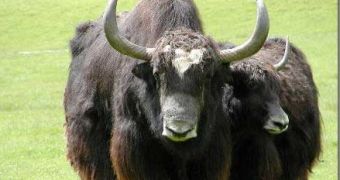The yak is a long-haired type of cattle, bred from Himalaya (Nepal) to Tibet, Mongolia and surrounding regions.
This is an animal perfectly adapted to high altitudes; it does not get altitude sickness, like other burden beasts. The yak is much better adapted for transporting loads across the Himalayan passages than the horse. Without them, those climbing the Everest would have to leave part of their equipment to the base. Moreover, the animal subsists with a very poor diet made of scarce vegetation encountered at those heights, but it copes more difficultly with altitudes under 3,000 m (10,000 ft). The connection between various areas of Himalaya and Tibet can be made only on foot or on the yak's saddle.
In the Tibet areas, homes are designed as rectangular structures, with an open central courtyard. Animals and humans will live together in this home, with much of the first floor dedicated to housing the yaks and other domestic animals, while people live on the second floor.
The domestic yak is shorter and stalker then wild yaks, which are huge animals, up to 1,200 kg (2,800 pounds) in weight. The yak is an excellent labor and burden animal, but besides being robust, it is at the same time obstinate and it can turn aggressive at the slightest attempt to displease it. That's why, in lower altitudes, people prefer a hybrid yak-cattle called zopkio, more docile and better standing with those conditions.
The spun yak wool is extremely warm. The braided wool is used for getting solid ropes. In Tibet and high Himalaya, the local common outfit is called chuba. Chuba is made by men who braid it from yak wool, the fabric signaling the tribal root and the social class. The yak wool is also used for making mantles and blankets.
The base diet of these people is butter tea, made of tea leaves, yak butter and salt (the beverage is said to have a wool scent) with tsampa (local barley or wheat bread).
Yak meat is slightly tough. In Chinese traditional medicine, sliced and pickled ox or yak penis, which has bland and rubbery texture, is considered a general energizer. In Tibetan monasteries, lamps on the shrines function on yak fat.
Yak skin is used for making from sandals to boats on wooden frames, extremely light and watertight. The dung is a precious fuel in a region where wood is very scarce.
At 3,000-3,500 m in Tibet and Himalaya, people can cultivate potato, barley, buckwheat and, rarely, corn. The small patches of arable land that can be extorted from the mountain are cultivated with the hoe or a yak-dragged plow.

 14 DAY TRIAL //
14 DAY TRIAL //